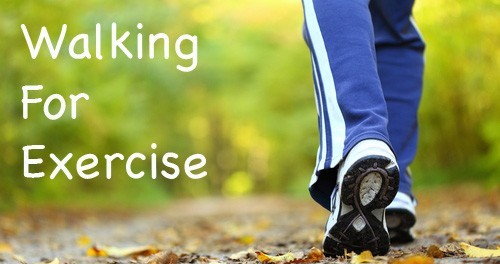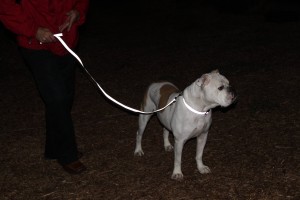Walk Talk Series
Day 50 – Night Walking and Night Cravings
Night Cravings
Many people find it easy to stick with their eating plans during the day. They have no breakfast or a light one, a healthy lunch, and avoid snacking. But then at the dinner hour they can’t take it any longer and end up overeating, or going back for desserts and bags of salty snacks while watching TV.
How to beat this habit? First, use the food diary to pinpoint this habit and when it affects you most. Then plan better what to eat, and how often, during the day so you aren’t left ravenous by the end of the day. Plan a healthy meal and evening snack so you aren’t left night munching.
Welcome to Week 8. This week we discuss walking in various kinds of weather and conditions.
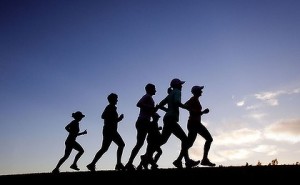 Today’s Walk Fat-Burning Walk:
Today’s Walk Fat-Burning Walk:
- 40-75 minute walk in the fat-burning zone at 60-70% of your maximum heart rate
- Warm up with 5 minutes at a very easy pace
- Find a safe spot with a wall or pole to do a 5 minute easy stretching routine
- Now resume your walk at a comfortable pace
- End with 5 minutes of gentle stretching
Advanced walkers: Distance Walk
Exercise: Abdominal Workout
Night Walking Strategies
Light colors, reflective striping, reflective fabrics and lights can keep you from tangling with a car. If you must wear black, you should add reflective striping or wear a reflective safety vest.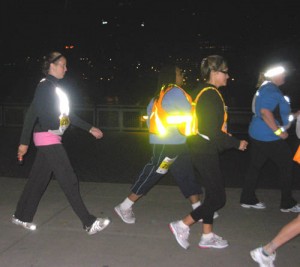
- When to Glow: You should wear visibility-enhancing clothes and accessories from an hour before sunset until an hour after sunrise.
- What Should Glow: Your walking outfit should provide reflective striping all along your body line to ensure you are seen and recognized as a human. A single patch is not enough. Look for jackets and pants that have a reflective stripe down the length of the sleeves and legs.
- Head to Toes: Look for a cap or headband that is reflective. Most running shoes have reflective patches.
- Vest: The best bet is to wear a reflective safety vest, available in the bike section of most sporting goods stores or at running stores. These are specially rated to be visible at a distance to drivers, and they also have bright orange elements to help for visibility at twilight. These mesh vests are completely breathable and add no weight.
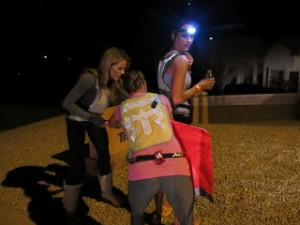 See and Being Seen – Flashlights, Headlamps, and Flashers
See and Being Seen – Flashlights, Headlamps, and Flashers
Carrying a flashlight in your hand closest to traffic provides another chance for cars to see you. A flashlight or headlamp is also essential for walking safely to see hazards in your path where there are no streetlamps. Or, you may attach small clip-on lights and flashers to your pack or belt. You can find these in the bicycle section of a sporting goods store. A headlamp keeps your hands free and doesn’t crimp your arm swing. Try on headlamps for comfort – get one with adjustable straps so you get a good fit. You can find a variety of headlamps at outdoors and hunting stores.
Night Walking Safety
You will need to be more defensive in your walking at night than in the day, although caution is always needed as cars often do not look for you or expect you to be there. You may wish to modify your path if you have a choice of routes. Choose those with the best street lighting and best sidewalks or paths that are separated from traffic.
1. Use sidewalks and off-road paths: Separate yourself as much as possible from traffic by seeking out lighted paths and sidewalks.
2. Walk facing traffic: When you cannot avoid walking on the side of the road, always walk on the side of oncoming traffic so you can see and react to any vehicle. Do not walk with your back to overtaking traffic.
3. Extra caution crossing streets: Traffic does not expect pedestrians to be out walking at night. Even when crossing with a crossing light, assume that the cars that may be turning across your path do not see you.
4. Safety in numbers: Use the same routes used by other walkers and runners. Drivers are more used to seeing them there.
5. Don’t get tripped: Tripping hazards are worse after dark. Uneven sidewalks, roots and rocks on trails, potholes and trash on the side of streets and roads – all can lead to a slip or fall. Walk with your eyes noting the ground 15 feet ahead to see upcoming hazards.
6. Blinded by the light: As we age we lose our ability to see well in the dark and recovering after having headlights shine in your eyes. Choose a path where you won’t have frequent changes in the lighting level. Do not look straight into oncoming headlights.
Fear of strangers in the night keeps many walkers off the trail from dusk to dawn. But there are steps you can take to reduce the risk.
1. Buddy up: Walk with a friend. This greatly reduces the risk of attack; the potential attacker is looking for privacy and the fewest witnesses. If you do not have a walking partner, use routes that have many other walkers and runners.
2. Walk the dog: An attacker will wait for somebody who doesn’t have a dog to come along instead. Even a small dog can add so many variables – they can bite, they can bark, etc.
3. Carry a stick: A hiking stick, or using two walking poles, can also make you a less appealing target. Using walking poles or a stick in icy/snowy winter weather adds stability and helps prevent falls as well.
4. Aware attitude: Walk purposefully – know where you are going and keep your head up and aware of everything around you. Attackers often are looking for those who are distracted and oblivious.
5. Know your trail: Know where you can contact help along your route – businesses, neighbors, etc. This is also important in case of a medical emergency.
6. Don’t go there: If you see a suspicious person or vehicle, cross the street or duck into a business or friend’s house.
7. Alarms: A wearable alarm can help alert those around you that you need help. But it should only be used as a backup when the other methods fail. A cell phone is also useful for calling for help. But when seconds count it is only useful for reporting a problem, not preventing one.
8. Weapons: Only carry a weapon if you are trained in using it safely, effectively and in accordance with all local laws. Pepper spray, tasers, knives, guns, etc. are only a last resort when you have failed to deter an attacker by other methods.

